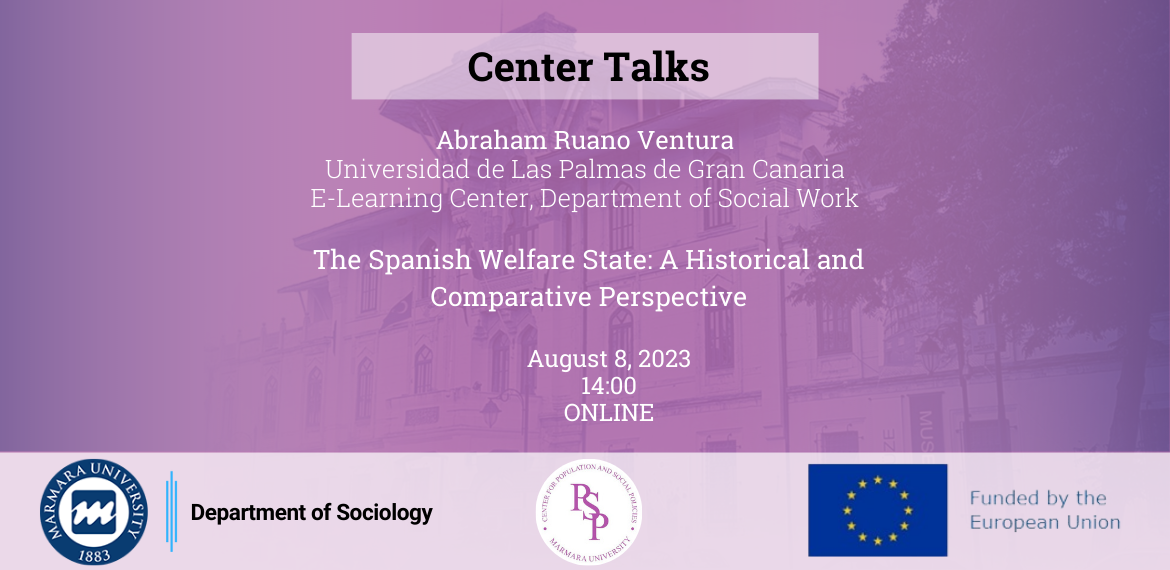
The Spanish Welfare State: A Historical and Comparative Perspective
Abraham Ruano Ventura - Universidad de Las Palmas de Gran Canaria, E-Learning Center, Department of Social Work
Date: August 8, 2023
Time: 14:00
Location: ZOOM
Link for Zoom: https://us06web.zoom.us/j/86918528019?pwd=N3dSUzUrUE80MExiRTR6NURnK3lKUT09
Summary
In this presentation, we delve into the foundation and evolution of the Spanish welfare state, tracing its historical development and highlighting its main characteristics today. From its inception to its current state, the welfare system in Spain has undergone significant changes that have shaped the current model.
The roots of Spain's welfare state can be traced back to the early 20th century when the first social policies were established, primarily focusing on labor rights and social security. However, the welfare state faced limited development during the early Francoist dictatorship, marked by economic aftermaths of the coup d'état and civil war, resulting in scant social spending and a lack of comprehensive welfare programs.
Between 1960 and 1990, substantial efforts and social investments laid the basis for what is now known as the Spanish Welfare State. Although rapid development occurred during this period, subsequent retrenchment followed, and significant progress has been elusive since then.
A distinct feature of the Spanish welfare state is its decentralized structure, granting considerable autonomy to its 17 autonomous communities. This regional autonomy has led to diverse welfare policies across the country, with some regions offering more comprehensive social services than others.
Over the late 20th and early 21st centuries, Spain encountered significant economic challenges, including the 2008 financial crisis, which severely impacted its welfare state. The crisis necessitated cuts in public spending, including social programs, leading to the implementation of austerity measures to address fiscal pressures.
Spain is typically classified within the Mediterranean model when comparing with other social welfare systems, reflecting similarities with other Southern European countries. In contrast to some European countries, Spain employs a more targeted approach, combining social security contributions with means-tested social assistance for specific groups, such as low-income families, the elderly, and individuals with disabilities. Family networks and informal support systems play a vital role in supplementing formal social assistance, and the informal economy is relatively more prevalent in Spain compared to other European countries.
Strengths of the Spanish welfare state include its healthcare system, which performs well in many areas. The pension system also demonstrates certain strengths, with high pension coverage and relatively good pension adequacy, resulting in a lower incidence of elderly poverty. According to the Organization for Economic Co-operation and Development (OECD), the average replacement rate in Spain is around 72%, higher than the OECD average of 63%.
However, weaknesses persist in the inadequacy of income support systems, leaving a significant portion of the population vulnerable to poverty. Eurostat data from 2019 shows that approximately 21.8% of Spaniards were at risk of poverty or social exclusion. Furthermore, regional inequalities remain a persistent and complex issue, rooted in historical, economic, and political factors.
Additionally, Spain exhibits a lower rate of public housing but a higher homeownership rate compared to other developed countries. The country's education spending as a percentage of GDP is also lower than the average of other developed nations.
In conclusion, understanding the historical and comparative perspective of the Spanish welfare state provides valuable insights for policymakers to address challenges and build a more equitable and inclusive social welfare system for the nation. Efforts to strengthen income support, reduce regional disparities, and improve housing and education policies can contribute to a more robust and balanced welfare state in Spain.
You can watch the event on the YouTube channel: https://youtu.be/p6HW_3me5DY
.png)
This page updated by Nüfus ve Sosyal Politikalar Uygulama ve Araştırma Merkezi on 11.02.2024 20:51:37
